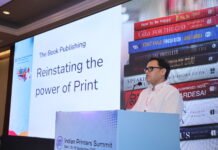Nielsen India Book Market Report 2015: Understanding the India Book Market conducted in association with the Association of Publishers in India (API) and the Federation of Indian Publishers (FPI) evaluated India’s book market industry’s opportunities, challenges and its future. Nielsen Book is a leading provider of search, discovery, commerce, consumer research and retail sales analysis services globally. The company runs the registration agencies (ISBN and SAN Agencies for UK & Ireland, ISTC) and provides search and discovery products through its Nielsen BookData product range, electronic trading via Nielsen BookNet and PubEasy services, retail sales analysis via Nielsen BookScan and consumer research through its Books and Consumer Survey.
India’s book market is the sixth largest in the world and it is currently worth Rs 26,100 crore and according to the survey by 2020 it is expected to reach Rs 73,900 crore. “We are extremely pleased to have launched the report; it is truly a first in many ways for India’s burgeoning print book market. The market in India has seen a double-digit growth in the last four years, and our studies peg India as the second largest English-language book market in the world, with the print book market at the sixth position globally. This intensive report captures the vernacular print market in India, as well as the resurgence of Indian authors writing in English – tracking in-depth trends that have attributed to the rise of the market in India. . . .The rise in literacy, a growing middle class and greater disposable income hold significant opportunities for the future growth of publishing businesses in India,” said Prashant Singh, managing director of Nielsen India. The report says that in the next five years the industry would have a 19.3% of compound annual growth rate (CAGR) despite the fact that the Indian book industry does not receive direct investment from the government – a serious roadblock for publishers.
Challenges
A tortuous distribution system; increases in direct costs; difficulty in managing cash flows due to long credit cycles; and publishing and bookselling’s fragmented nature are the other obstacles that India’s book industry has to go through including piracy which is widespread, with almost every stall and street in the country selling pirated texts. “This combined with a lack of industry recognition, support and policies make it more challenging for publishers in the Indian publishing industry. A key recommendation is for the automation of certain sectors, for instance, publisher prefix and ISBN allocation which could improve the process and flow of information for publishers, large and small. However, the overall growth of the market is very encouraging for existing and new players,” said Vikrant Mathur, director of Nielsen Book India.
Contribution in English language
Among several other facts, the report also highlights that when it comes to English-language print book publishers, India is the second largest in the world with over 9,000 publishers. In addition, more than 70% of publishers in India have digitized their content to produce eBook versions such as eReaders and smartphones.
For eCommerce, business books have emerged as an instrumental category. It is now accounting for 15% of the entire eCommerce trade. The study further said that in the academic books segment the most sought-after genre was test prep whereas general and literary fiction topped the genre in the trade books section. “The India Book Market report delves into the publishing landscape in the country – size and potential of the industry, what challenges it faces and what opportunities lie ahead. Various government initiatives and policies affecting publishing; the status of education in India; book retailing and the digital publishing industry as the future of publishing, have all been discussed at length. It also reveals some interesting facts about the industry – such as the size of publishing being larger than the Indian film industry,” said Vikas Gupta, president of API.














